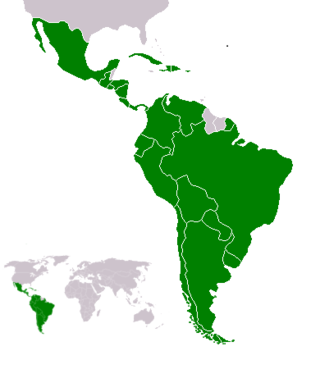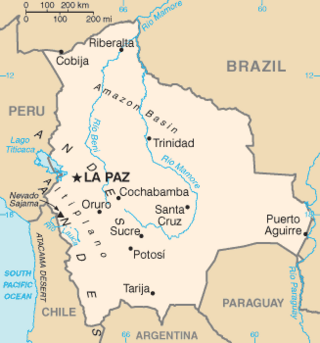Related Research Articles

The World Bank Group (WBG) is a family of five international organizations that make leveraged loans to developing countries. It is the largest and best-known development bank in the world and an observer at the United Nations Development Group. The bank is headquartered in Washington, D.C. in the United States. It provided around $98.83 billion in loans and assistance to "developing" and transition countries in the 2021 fiscal year. The bank's stated mission is to achieve the twin goals of ending extreme poverty and building shared prosperity. Total lending as of 2015 for the last 10 years through Development Policy Financing was approximately $117 billion. Its five organizations are the International Bank for Reconstruction and Development (IBRD), the International Development Association (IDA), the International Finance Corporation (IFC), the Multilateral Investment Guarantee Agency (MIGA) and the International Centre for Settlement of Investment Disputes (ICSID). The first two are sometimes collectively referred to as the World Bank.

The United Nations Development Programme (UNDP) is a United Nations agency tasked with helping countries eliminate poverty and achieve sustainable economic growth and human development. The UNDP emphasizes developing local capacity towards long-term self-sufficiency and prosperity.

The Inter-American Development Bank is an international financial institution headquartered in Washington, D.C., United States of America, and serving as the largest source of development financing for Latin America and the Caribbean. Established in 1959, the IDB supports Latin American and Caribbean economic development, social development and regional integration by lending to governments and government agencies, including State corporations.

The French Development Agency is a public financial institution that implements the policy defined by the French Government. It works to fight poverty and promote sustainable development. This public institution is active in Africa, Asia, the Middle East, Latin America, the Caribbean and the French overseas territories, where it finances and supports projects that improve living conditions for populations, promote economic growth and protect the planet.
The Chad–Cameroon Petroleum Development and Pipeline Project is a controversial project to develop the production capacity of oilfields near Doba in southern Chad, and to create a 1,070-kilometre (660 mi) pipeline to transport the oil to a floating storage and offloading vessel (FSO), anchored off the coast of Cameroon, near the city of Kribi. It is operated by ExxonMobil (40%) and also sponsored by partners forming the consortium, Petronas (35%) and Chevron (25%). The governments of Chad and Cameroon also have a combined 3% stake in the project. The project was launched on October 18, 2000, and completed in June 2003.
A community development financial institution (US) or community development finance institution (UK) - abbreviated in both cases to CDFI - is a financial institution that provides credit and financial services to underserved markets and populations, primarily in the USA but also in the UK. A CDFI may be a community development bank, a community development credit union (CDCU), a community development loan fund (CDLF), a community development venture capital fund (CDVC), a microenterprise development loan fund, or a community development corporation.

Water supply and sanitation in Latin America is characterized by insufficient access and in many cases by poor service quality, with detrimental impacts on public health. Water and sanitation services are provided by a vast array of mostly local service providers under an often fragmented policy and regulatory framework. Financing of water and sanitation remains a serious challenge.
Drinking water supply and sanitation coverage in Honduras has increased significantly in the last decades. However, the sector is still characterized by poor service quality and poor efficiency in many places. Coverage gaps still remain, particularly in rural areas.
Drinking water and sanitation in Nicaragua are provided by a national public utility in urban areas and water committees in rural areas. Despite relatively high levels of investment, access to drinking water in urban areas has barely kept up with population growth, access to urban sanitation has actually declined and service quality remains poor. However, a substantial increase in access to water supply and sanitation has been reached in rural areas.
Bolivia's drinking water and sanitation coverage has greatly improved since 1990 due to a considerable increase in sectoral investment. However, the country continues to suffer from what happens to be the continent's lowest coverage levels and from low quality of services. Political and institutional instability have contributed to the weakening of the sector's institutions at the national and local levels. Two concessions to foreign private companies in two of the three largest cities—Cochabamba and La Paz/El Alto—were prematurely ended in 2000 and 2006 respectively. The country's second largest city, Santa Cruz de la Sierra, relatively successfully manages its own water and sanitation system by way of cooperatives. The government of Evo Morales intends to strengthen citizen participation within the sector. Increasing coverage requires a substantial increase of investment financing.

Access to water supply and sanitation in Ethiopia is amongst the lowest in Sub-Saharan Africa and the entire world. While access has increased substantially with funding from foreign aid, much still remains to be done. Some factors inhibiting the achievement of these goals are the limited capacity of water bureaus in the country's nine regions, two city administrations and water desks in the 770 districts of Ethiopia (woredas); insufficient cost recovery for proper operation and maintenance; and different policies and procedures used by various donors, notwithstanding the Paris Declaration on Aid Effectiveness.

Bolivia has traditionally undertaken different water resources management approaches aimed at alleviating political and institutional instability in the water sector. The so-called water wars of 2000 and 2006 in Cochabamba and El Alto, respectively, added social unrest and conflict into the difficulties of managing water resources in Bolivia. Evo Morales’ administration is currently developing an institutional and legal framework aimed at increasing participation, especially for rural and indigenous communities, and separating the sector from previous privatization policies. In 2009, the new Environment and Water Resources Ministry was created absorbing the responsibilities previously under the Water Ministry. The Bolivian Government is in the process of creating a new Water Law – the current Water Law was created in 1906 – and increasing much needed investment on hydraulic infrastructure.

Self Help Africa is an international charity that promotes and implements long-term rural development projects in Africa. Self Help Africa merged with Gorta in July 2014, and in 2021 merged with UK-based INGO, United Purpose. The organisation also owns a number of social enterprise subsidiaries - Cumo Microfinance, TruTrade and Partner Africa.
Canadian Lutheran World Relief (CLWR) is a humanitarian agency engaged in community development, refugee resettlement, emergency relief, basic commodity shipments, volunteer placement and alternative trade. It has four main programs: Humanitarian Response, Food Security and Livelihoods, Education and Skills, and Refugee Resettlement.
Community-driven development (CDD) is an initiative in the field of development that provides control of the development process, resources and decision making authority directly to groups in the community. The underlying assumption of CDD projects are that communities are the best judges of how their lives and livelihoods can be improved and, if provided with adequate resources and information, they can organize themselves to provide for their immediate needs. CDD projects work by providing poor communities with direct funding for development with the communities then deciding how to spend the money. Lastly, the community plans and builds the project and takes responsibility for monitoring its progress.
Proparco is a Development Finance Institution partly owned by the French Development Agency (AFD) and private shareholders from the developed countries.
Pakistan Poverty Alleviation Fund (PPAF) is a Pakistani Not-for-Profit company based on the model of public-private partnership. PPAF aims to promote an effective approach to poverty alleviation across Pakistan. A number of leading multilateral, bilateral, and international corporate institutions such as the World Bank contribute to PPAF’s poverty reduction goal by providing financial support and funds to promote grassroot development. This 'Fund' mostly helps by providing microfinance loans to the very poor households to help lift them out of poverty.
The Poverty Reduction Strategy (PRS) is a country-based process which leads to the formation of a Poverty Reduction Strategy Paper. The paper is then presented to major donors such as the International Monetary Fund (IMF) and the World Bank for approval. Approval allows foreign aid to be given to the country. Approval was given to Honduras on August 20, 2001. Honduras' goal was to reduce the rate of poverty in the nation from 70 percent to 40 percent by 2015. The PRS was a continuation of the "Master Plan for Reconstruction and National Transformation." The PRS had an annual budget of 4.4 million Honduran lempiras which was distributed in about 300 million lempira lots to each of 18 of the Honduran Government departments. The funds were to be used for specific projects aimed at benefiting communities.

The Saudi Fund for Development (SFD) is a Saudi Arabian government agency that provides development assistance to developing countries by financing social and infrastructure projects with the aim of improving lives and communities, which leads to supporting the economies of recipient countries by enhancing growth and job opportunities. SFD was established in 1974 and began operations in 1975. SFD's activities include development, finance, trade and funding. SFD is led by H.E. Mr. Ahmed bin Aqeel Al-khateeb who is the Chairman of the Board of Directors and Minister of Tourism for Saudi Arabia. Dr. Khalid S. Alkhudairy is the Chief Executive Officer (CEO) of SFD.
The African Solidarity Fund (ASF), also known by its French name and acronym, is a multilateral, financial guarantee institution based in Niamey, Niger. The purpose of the ASF is to contribute to the economic and social development of its regional member states by facilitating access to credit for states and public and private enterprises in its area of operation, to finance productive investment projects, and to mobilize local and external savings, in particular by providing loan guarantees on the financial markets.
References
- ↑ While in principle a Social Fund is a financing facility, in practice the term has become synonymous to the agencies that typically run the financing facility
- ↑ World Bank on PPAF
- ↑ World Bank
- ↑ WorldBank: Development Outreach
- ↑ Rawlings, LB; Sherburne-Benz, L; Domelen, JV (2004). Evaluating social funds - a cross country analysis of community investments (PDF). United States: World Bank. pp. xvi–xxvii. ISBN 0821350625 . Retrieved 2 February 2023.
- ↑ Fondo de Inversión Productivo Social Archived 2008-12-18 at the Wayback Machine